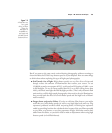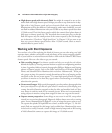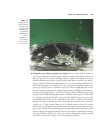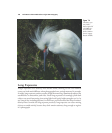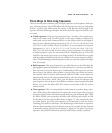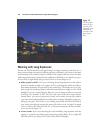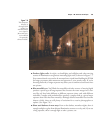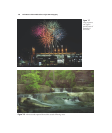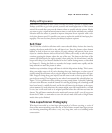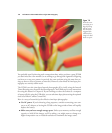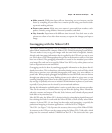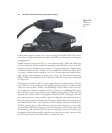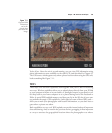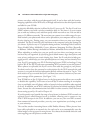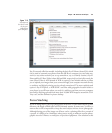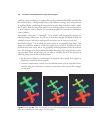
Delayed Exposures
Sometimes it’s desirable to have a delay of some sort before a picture is actually taken.
Perhaps you’d like to get in the picture yourself, and would appreciate it if the camera
waited 10 seconds after you press the shutter release to actually take the picture. Maybe
you want to give a tripod-mounted camera time to settle down and damp any residual
vibration after the release is pressed to improve sharpness for an exposure with a rela-
tively slow shutter speed. It’s possible you want to explore the world of time-lapse pho-
tography. The next sections present your delayed exposure options.
Self-Timer
The D7000 has a built-in self-timer with a user-selectable delay. Activate the timer by
rotating the release mode dial to the self-timer icon. Press the shutter release button
halfway to lock in focus on your subjects (if you’re taking a self-portrait, focus on an
object at a similar distance and use focus lock). When you’re ready to take the photo,
continue pressing the shutter release the rest of the way. The lamp on the front of the
camera will blink slowly for eight seconds (when using the 10-second timer) and the
beeper will chirp (if you haven’t disabled it in the Custom Settings menu, as described
in Chapter 9). During the final two seconds, the beeper sounds more rapidly and the
lamp remains on until the picture is taken.
Another way to simulate a longer self-timer is with the Mup mirror lockup. This is some-
thing you might want to do if you’re shooting close-ups, landscapes, or other types of
pictures using the self-timer only to trip the shutter in the most vibration-free way pos-
sible. Forget to bring along your tripod, but still want to take a close-up picture with a
precise focus setting? That happened to me when I encountered this colorful plant (see
Figure 7.9) in a greenhouse when picking up some potted plants. I wheeled a planting
cart over to the blossom, rested the camera on a soft bag of potting soil (a beanbag would
have been better!), carefully focused, and let the self-timer trip the shutter at the appro-
priate moment. In such situations, the camera might teeter back and forth for a second
or two, but it will settle back to its original position before the self-timer activates the
shutter. The self-timer remains the active mode until you turn it off—even if you power
down the D7000—so remember to turn the release mode dial back to Single frame
mode when you’re finished.
Time-Lapse/Interval Photography
Who hasn’t marveled at a time-lapse photograph of a flower opening, a series of
shots of the moon marching across the sky, or one of those extreme time-lapse picture
sets showing something that takes a very, very long time, such as a building under
construction.
Chapter 7 ■ Advanced Techniques 191



